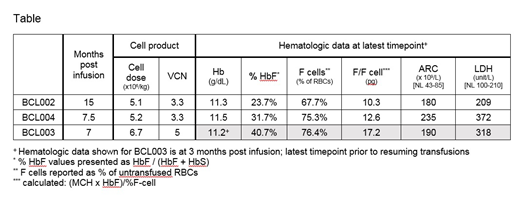BCL11A regulates the fetal-adult hemoglobin switch by repressing expression at the gamma (γ)-globin locus (Sankaran et al., Science, 2008), and thus it represents an appealing therapeutic target for sickle cell disease (SCD). BCH-BB694 is a lentiviral vector (LVV) encoding a shRNA targeting BCL11A embedded in a microRNA scaffold (shmiR) allowing erythroid-specific knockdown to induce γ-globin expression and concomitantly and coordinately repress β-sickle globin expression (Brendel et al. JCI, 2016). In a pilot and feasibility gene therapy study we are evaluating the safety of infusion of BCH-BB694-transduced autologous CD34+ cells in patients with severe SCD. The study is an IND enabled and IRB approved open label, non-randomized, single center trial (NCT 03282656). We report here data from the full adult cohort which has completed enrollment with > 6 months of follow up in all patients. The adult cohort included three patients >/= 18 years old. Autologous CD34+ cells were collected by plerixafor mobilization and then transduced ex vivo with the BCH-BB694 shmiR lentiviral vector. Cell doses and vector copy number (VCN) are shown in the Table. After testing and release, gene modified cells were infused into subjects who had received busulfan conditioning. There were no Grade 3 or 4 AEs associated with mobilization, collection or infusion. All three adults (age 21-26 years old) demonstrated neutrophil engraftment on day +22 with adverse events consistent with busulfan conditioning. These patients are now 7, 9, and 17 months post infusion. One subject resumed red cell transfusions at 3 months due to pre-existing moyamoya using a pre-defined conservative trigger value of 40% sickle Hb in whole blood and will be detailed separately. There have been no adverse events related to the gene therapy product. VCN has been stable in bone marrow (BM) and peripheral blood (PB) in all cell lineages during the length of the study, with the latest time point studied at 15 months (BCL002) and ranged from 0.45-2.85 copies per cell in erythroid progenitor cells. BCL11A protein levels evaluated by immunoblot in subject BCL002 at 30 days (PB) and 6 months (BM) post-infusion showed highly effective and selective knockdown of BCL11A in erythroid progenitors with no reduction in BCL11A expression in B lymphoid cells. The number of HbF-containing cells (F cells) was assessed by flow cytometry and the kinetics of F cell production was remarkably similar in all subjects. The two untransfused subjects (BCL002 and BCL004) produced 70% F-cells in PB at 3 and 5 months, which has remained stable until the last point assayed (15 months and 7.5 months, respectively) (table). Calculated average HbF per F cell was >10pg in all subjects (table) and quantitative single cell HbF flow analysis showed the majority of F cells had >4pg F/cell, a level that is believed to prevent sickling under physiological oxygen saturation (Rakotoson et al., ASH 2017). In both untransfused subjects, total Hb remained stable with evidence of reduced hemolysis by reticulocyte count (slightly elevated) and LDH (normal in one subject, slightly elevated in the other). At the 3-month timepoint before re-starting transfusions, the subject with moyamoya (BCL003) had a pre-transfusion Hb of 11 g/dL with 76% of non-transfused cells containing on average 17pg F/F cell. For all subjects, we estimated the fraction of RBCs containing significant Hb sickle polymers and the amount of polymer in each sickled RBC at physiologic oxygen tension (where 50% of monomeric hemoglobin was oxygen saturated, or the P50) (Di Caprio et al. PNAS 2019, in press). The results for all 3 subjects in this adult cohort showed fewer RBCs with significant Hb polymer than two hydroxyurea-responsive treated comparators and significantly less Hb polymer per sickled RBC than a third highly responsive hydroxyurea-treated comparator. In conclusion, these data demonstrate successful and sustained engraftment in three adult patients treated with LVV-delivered shmiR technology targeting BCL11A. Early results suggest an acceptable safety profile, validation of BCL11A as effective target for HbF induction in humans with high numbers of F cells in circulation containing high levels of HbF per F cell, and mitigation of cellular pathology of SCD.
Achebe:Global Blood Therapeutics: Membership on an entity's Board of Directors or advisory committees; Pharmacosmos: Membership on an entity's Board of Directors or advisory committees; Fulcrum Therapeutics: Membership on an entity's Board of Directors or advisory committees; Bluebird Bio: Membership on an entity's Board of Directors or advisory committees. Bartolucci:Novartis: Membership on an entity's Board of Directors or advisory committees; AddMedica: Honoraria, Membership on an entity's Board of Directors or advisory committees; Roche: Membership on an entity's Board of Directors or advisory committees; HEMANEXT: Membership on an entity's Board of Directors or advisory committees; Global Blood Therapeutics: Membership on an entity's Board of Directors or advisory committees; Agios: Membership on an entity's Board of Directors or advisory committees. Heeney:AstraZeneca: Research Funding; Micelle Biopharma: Consultancy, Membership on an entity's Board of Directors or advisory committees, Research Funding; Pfizer: Research Funding; Novartis: Consultancy, Research Funding; Ironwood / Cyclerion: Research Funding; Vertex / Crisper Therapeutics: Other: Data Safety Monitoring Board. Higgins:Sanofi: Consultancy, Research Funding. Nikiforow:Kite/Gilead: Honoraria; Novartis: Honoraria; NKarta: Honoraria. Wood:Sanofi: Consultancy, Research Funding. Williams:Alerion Biosciences: Other: Co-founder; Novartis: Membership on an entity's Board of Directors or advisory committees; Orchard Therapeutics: Membership on an entity's Board of Directors or advisory committees, Other: Co-founder, Patents & Royalties: Potential for future royalty/milestone income, X-SCID., Research Funding; bluebird bio: Patents & Royalties: Licensed certain IP relevant to hemoglobinopathies to bluebird bio. Received payment in the past bluebird bio through a BCH institutional licensing agreement and there is a potential for future royalty/milestone income from this agreement., Research Funding.
Author notes
Asterisk with author names denotes non-ASH members.


